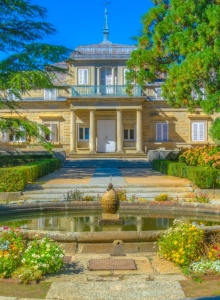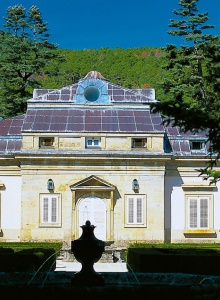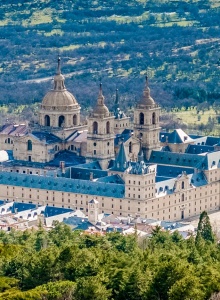In the heart of the Guadarrama mountain range, only 50 kilometres from Madrid, stands the town of San Lorenzo de El Escorial.
Mount Abantos, its pine forests and the Herrería estate form the natural surroundings of this place, which has its focal point in the Monastery of El Escorial. Its urban layout is composed of a harmonious collection of ancestral homes in the Herrera style, with rationalist avenues and small squares in an earlier style. Nestling in the Madrid mountains, it offers a great many leisure opportunities and cultural routes, such as those which take the visitor to Ávila, Segovia, Toledo or Madrid.
The Madrid-region town of San Lorenzo del Escorial, a Historic-Artistic Site, grew up around the Monastery of El Escorial. This architectural gem, declared a World Heritage Site by UNESCO, was ordered to be built by Felipe II in the 16th century to commemorate the Battle of San Quintín. An urban layout slowly developed around it, since the aristocrats and middle classes from the capital had their summer residences erected here. It is, in short, an elegant town rich in architectural heritage and surrounded by mountains and forests.The MonasteryThe Royal Monastery is a complex structure designed by Juan Bautista de Toledo and built by Juan de Herrera. The simplicity of its lines focus all the attention on the harmony of its courtyards, fountains, cloisters and towers. More than 4,000 rooms are distributed among the principal areas. The Courtyard of the Kings of Judea gives way to the Basilica, which has a dome base measuring 95 metres and paintings by Lucas Jordán among its major features.San Lorenzo was also built to house the Royal Pantheon and the Spanish monarchs from the houses of Habsburg and Bourbon are buried here. The princes, infantes and queens who died without leaving royal descendents rest in the Pantheon of the Infantes.In the Museum of Architecture there are documents concerning the work carried out to build the Monastery, which state that grand masters came from all over Europe to participate in its construction. Also outstanding are the great many manuscripts (in Arab, Greek and Latin) in its Library and the invaluable collection of paintings in the Chapter Houses. El Greco, Ribera, Tiziano, Velázquez or Bosch are just some of the artists whose work is on display. Tiziano, Veronés, Zurbarán and Tintoretto await the visitor in the Painting Museum.San Lorenzo de El EscorialBetween the Exchange, an enormous square surrounding this architectural site, and the street of Floridablanca is the sober structure of the Servants' and Guest Quarters. Designed to house the palace outbuildings, they are remarkable for their ashlar stones and slate rooves. Meanwhile, the current University of Santa Cristina was built to house the ovens, kitchens, stables, the blacksmiths and other monastery outbuildings, the so-called Servants' Quarters.Forming part of the urban design of this town, we well also find the House of the Infantes and the Queen, the Coliseum of Carlos III and other exceptional buildings. Houses and Small Palaces yield to the rationalist urban development which the symmetry of the Monastery sustains. The Palace of the Marquis of Campo Villar, the house of the Duke of Medinaceli or the House of the Columns are some wonderful examples.The current Euroforum, a place where the Summer Courses of the Madrid Complutense University are held, was in its day the house of the Families of the Infantes. Remodelled on several occasions over the centuries, it boasts the title of Historic--Artistic Monument.In the Herrería estate, with marvellous views over San Lorenzo, is theCottage of the Infante, or Higher Cottage. This small palace was ordered to be built by Infante Don Gabriel de Bourbon, son of Carlos III, to distance himself from palace protocol. Its layout and its gardens are the work of Juan de Villanueva.Gastronomy and surrounding areaIn San Lorenzo de El Escorial the visitor can also sample genuine Madrid and mountain cuisine. Snails, potato omelette and cold meats will serve as appetizers. Madrid stew (chickpeas, meat and vegetables), tripe and garlic soup are steeped in the purest Castilian tradition. Among the main courses, Guadarrama mountain beef is cooked on the grill, while lamb and suckling pig are prepared in the oven. Sea bream and cod are the preferred fish in the central region. And for dessert, aniseed "rosquillas", custard "canutitos" or almond "mantecados".Ávila, Segovia, Toledo and Madrid are cities worth visiting during a stay in San Lorenzo de El Escorial. The first three have been declared World Heritage Sites by UNESCO and possess historic quarters of unquestionable historic-artistic value. The walls and churches of Ávila; the aqueduct, Fortress and Cathedral of Segovia; and the cultural blend of Toledo are some of the principal charms. Madrid, meanwhile, has old quarters, such as Habsburg and Bourbon Madrid, where the visitor can take a quiet stroll and stop at the many monuments. The Prado, the Thyssen-Bornemisza Museum and the Reina Sofía National Art Centre, along with National Archaeological Museum, are some of the musts. A cosmopolitan city which has a number of shopping areas, green spaces and leisure spots, where the cultural programme allows for the most varied artistic expression.













